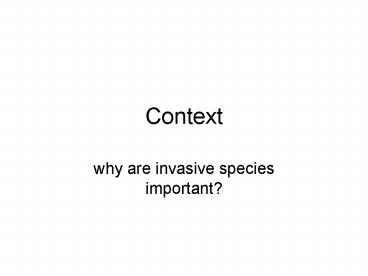Context - PowerPoint PPT Presentation
1 / 17
Title:
Context
Description:
control spread of alien species; ... The EU Imports Directive. From January 2005 ... actions ... to exclude alien pests and diseases from the Community. ... – PowerPoint PPT presentation
Number of Views:52
Avg rating:3.0/5.0
Title: Context
1
Context
- why are invasive species important?
2
Lots of Conventions, Agreements and Policies.
- Some examples
3
The International Convention on Biodiversity
- Title 8. In-situ Conservation
- regulate biological resources,
- promote protection of habitats
- restore degraded ecosystems
- recovery of threatened species
- control spread of alien species
4
The EU Imports Directive
- From January 2005
- actions to exclude alien pests and diseases
from the Community. - Phytosanitary checks on 100 of regulated plant
material from third countries will take place at
the first point of entry to the EU. - The intention is to increase the effort to
prevent the introduction of alien pests and
diseases rather than eradicate and contain them
once they have entered the EU.
5
International Maritime Organization Resolution
on Ballast Water
- Resolution A.868(20)
- GUIDELINES FOR THE CONTROL AND MANAGEMENT OF
SHIPS' BALLAST WATER TO MINIMIZE THE TRANSFER OF
HARMFUL AQUATIC ORGANISMS AND PATHOGENS
6
Global Invasive Species Network (GISN)
- Baltimore Declaration Mission statement
- To develop and share electronic information
management tools to better identify, map, and
predict the spread of invasive species at
regional and global levels.
7
Royal Horticultural Society (Policy of 2003)
- 3. The Society believes that a national body
should be charged with this responsibility and
given resources for monitoring and evaluating
potentially invasive plants and the co-ordination
of their control. - 5. Doesnt stock or allow to be shown Himalayan
Balsam, Giant Hogweed, Japanese Knotweed, fairy
fern, New Zealand pigmy weed, Parrots Feather
floating pennywort.
8
Rate of new introductions
In the Great Lakes about one new species per year.
9
Economics
- David Pimentel Cornell University loss from
invasive species (in the USA) 123 billion a
year. - Weeds cost Australia an average of 4 billion
a year. The cost has doubled in just 20 years and
is likely to increase.
10
Economics II
- Where do the estimates of the costs of invasive
species come from? RNT Consulting examined costs
of invasive species in Canada - 50 species examined in detail,
- 16 had some economic information
- 9 had solid economic data.
11
Economics IIIZebra Mussels in the Great Lakes
- 1989-1995 approximately US1 billion (C. ONeill,
Jr., pers. comm.) - 1989 Ontario Hydro 6 million to prevent clogging
(Manitoba Department of the Environment 1991). - 2000 Ontario Hydro 20 million, with an annual 1
million in operating costs (Legislative Assembly
of Ontario 2000). - 1989-2002 Ontario Power Total capital and
research expenditure 30 million, annual costs 5
to 8 million/year (Wiancko 2002). - 2001 The City of St. Catharines was told that
7.5 billion in expenditures on control
measures since 1989. - 2001 - cost of damage in the Great Lakes (Canada
and the U.S.) is over 3 billion (Commissioner of
the Environment and Sustainable Development
2001).
12
Interaction with People
- Some examples
13
Grey Squirrel in Italy
- 1948 - introduced into Piedmont
- 1970 - starts to spread.
- 1989 IUCN British Forestry Commission,
advises eradication. - 1996 - predicted to reach the Alps in two years,
population 2,500-6,400 individuals - 1997 - trial eradication in Racconigi Park
- June 1997 - animal rights group started court
case eradication stopped. - July 2000 - court acquits NWI.
- But they have now reached the forests of the
Alps and eradication is no longer feasible
14
Water cress in New Zealand
- Waikoropupu Springs home to an endemic moss
Hypnobartlettia fontana) - Spring fenced so cattle had no access.
- Watercress (Rorippa nastustrium-aquaticum)
suddenly expands and covers almost entire site. - 1990 - hand-weeding programme introduced
- Introduced rush, Juncus microcephalus, invaded
the bare areas and the recovering communities. It
has a stronger root system and its removal causes
much more disturbance. - 2000 - introduced aquatic grass species, Glyceria
fluitans and G. declinata invade the spring more
difficult to control than the Juncus.
15
Western Corn Rootworm in Europe
- 1992 one patch 500 m from Belgrade airport
- 1994 estimated cost of eradication 6-8 million
(but sanctions against Yugoslavia so nothing
happened) - Mid-1990s Hungary, Bulgaria Romania
- 1998 - Italy
- 2003 Switzerland Slovakia 2003
- Damage 400 million per year.
16
New Zealand Flatworm Arthurdendyus triangulatus
(formerly Artioposthia triangulata)
Belfast 1963, Edinburgh 1965 English
distribution in 2003 (n63)
17
Questions
- To what extant can we and should we include
interaction with people, either through the
movement of the species, modifications to the
habitat or social concerns? - To what extent can we rely on observed
distributions to validate models? - To what extent can we interact with economic
concerns?































